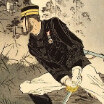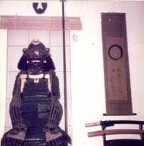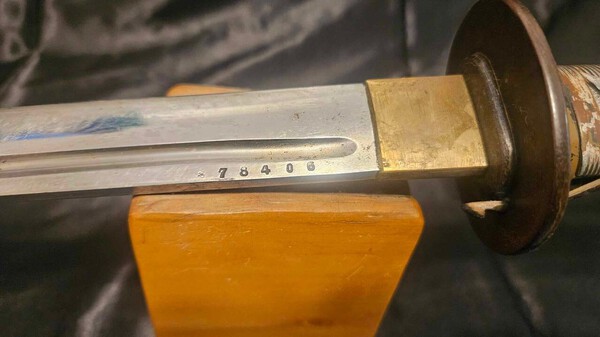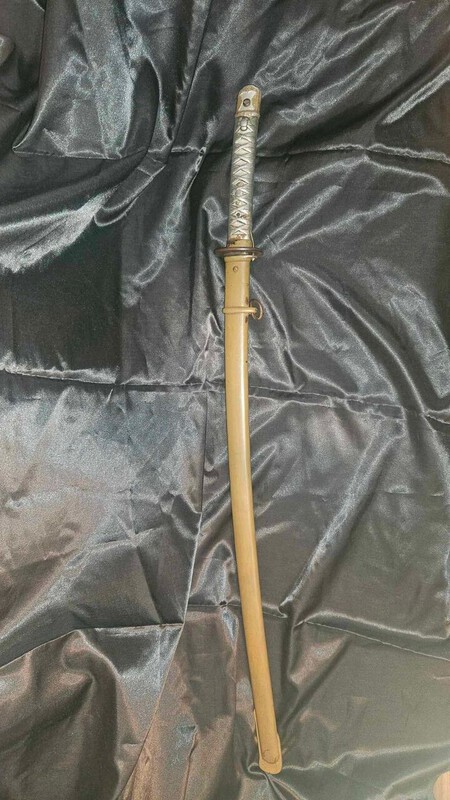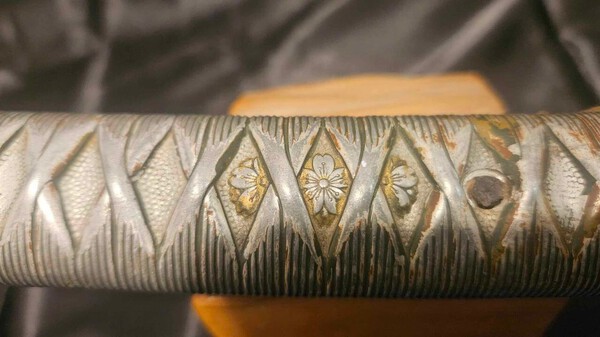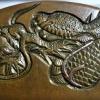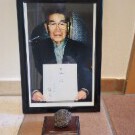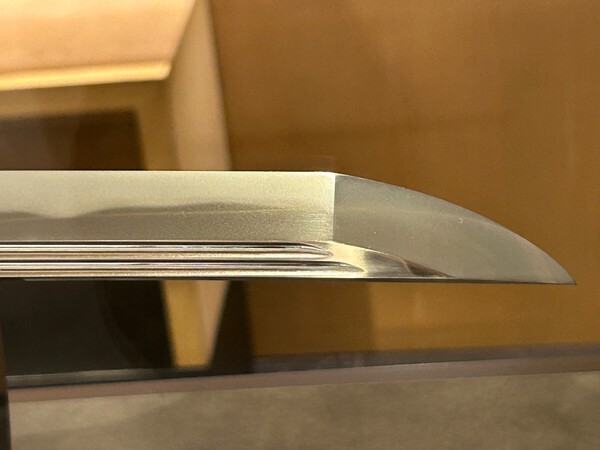Leaderboard
Popular Content
Showing content with the highest reputation on 08/08/2024 in all areas
-
I think it is probably time to offer an explanation of what was behind the original post and I am grateful to Brian for suggesting people select their first pick up. It helped illustrate the point I was hoping to make. The majority of participants selected no.4 as their first preference with no.3 coming in close behind. No.4 has been taken to a number of exhibitions and study days for people to examine. Sitting alongside other pieces it has been largely ignored. It is very conservative, the hada is not immediately visible and the complexity of the hamon needs close study. As a result people tended to leave it on the table and gravitate to the larger and more flamboyant pieces that were also on show. However when restricted to focusing on shape something people saw in no.4 drew them to it. The somewhat laboured point I am trying to make is that we should, as Walter Compton said in his 100 masterpiece volume, look at shape before we look at anything else. I still maintain that regardless of whether it is ubu or suriage a good sword will never have a bad shape. Once we have studied the shape move on to the other features that can tell us a great deal more. For those who want to know what they were looking at: 1. A mumei shin-shinto piece attributed to Aizo Tadamasa by the NTHK 2. O-suriage katana with old NBTHK papers to Daido. I think this falls in to what Darcy so eloquently described as a typical "bucket attribution" . it could be the work of a number of smiths and Daido was a safe choice. 3. Has a shumei and sayagaki attributing it to Aoe Tsunetsugu. The NBTHK Juyo papers from the 13th session attributed to Aoe and dated it to the late Kamakura period. Interestingly they do not describe it as having O-kissaki leaving it at extended chu-kissaki. They also mention the shumei but state that this does not refer to the Ko-Aoe master of that name. 4. This blade has three separate attributions to the same smith Awataguchi Norikuni who was working in 1220 and one of Go-Toba resident smiths. It has Hozon papers and as far as I am aware it has never been submitted for higher papers. It does however have a sayagaki by Tanobe Sensei in which he describes it as "A masterpiece of the Kamakura period". Awataguchi work is not common Norikuni's pieces are rare and highly regarded I think at the last count there were seven of his blades awarded Juyo certification and four of those were tanto. There is one national treasure piece which is suriage but retains the mei. This piece has a great many similarities to that work. This is amongst the finest examples of sword making I have had the opportunity to study in the past 40 years. However it requires time to look and appreciate it. looking at the shape first and in detail gives the observer that little extra time to start to see the detail.9 points
-
Love the question! I was 11 years old.. Thank god I didn’t do anything stupid with it at that age It belonged to my grandfather. The story of how he got it, is lost. Every time I would visit, I would ask to see it. He was pretty grumpy, and only occasionally agreed to show it to me. Anyway, he had a stroke, and I think he knew he was going to pass; because while visiting a couple weeks before my birthday, he decided to give it to me. He was only 73 and I was turning 11, and my parents shocked looks were priceless Anyway, after many lectures about the responsibility of owning a weapon. I took it home with me. He passed away a week later, RIP. Fast forward ~20 years, I take interest in it, post it here, and send it off to Ted for ID. He tells me its genuine, and early Shinto mino! I didn’t even know it was real for those 20 years. Nothing particularly valuable, but very special to me. Cheers, -Sam8 points
-
The Awataguchi is the superb blade clearly - not just because of the name but due the very graceful sugata. I also prefer old blades and emphatic curvature and my modest collection has mostly such blades. That was the whole purpose of the post - not to opine on quality or polish etc as that is not particularly visible here but focus on proportions. The proportions plus curvature make it stand out. Thank you Paul for posting this mental exercise.7 points
-
So, indeed shape is one of the first aspects that grab us, probably followed by proportions etc. But sometimes it might be misleading as to dating the blade. Paul’s Oei Yasumitsu is a case in point as it is shaped like an earlier sword. I attach an image of an early Kamakura kodachi, which typically people could probably not guess dates to 1245-1250 by looking at the sugata. Yet it is ubu or very nearly ubu. While the shape is not one of those curvaceous beauties, the sword’s hataraki and other activities more than make up for what the sugata does not offer.5 points
-
Great exercise Paul, has really been informative. Would love to see more of this sort of post, as it doesn't even cross over to that touchy subject of online kantei, but more of "gut feel" and what attracts us initially. More like this would be wonderful, and even more discussion in this particular thread. Really fun. Now when it comes to wakizashi...this gets even more tricky.5 points
-
In about 1970 when I was 15 years old I owned a few non Japanese swords . Each month I would attend the Antique Arms Collectors Guild meeting at the Hawthorn Band rooms . There was a signed Japanese blade in a gunto saya on sale for Eight dollars . That price was way too high . Each month the asking price would come down by a dollar and when it got to five dollars I bought it ( from underneath my good friend Barry Thomas's nose ) . I couldn't read the mei at the time but later was able to read it as Tojiro Hisakuni a famous koto maker . Gimei ,I am sure ,although one Japanese who saw it was pretty keen on it . It is something that I still own . Ian Brooks5 points
-
I was 24, living in London for my first corporate job. There was a little store near Camden Lock close to where I lived that sold Japanese prints and art. There was an o-suriage wakizashi on the shelf above the cash register. I was shocked to learn it was a real samurai sword and had to have it. The owner joked that I must be very savvy to buy a blade without a signature because it could be a treasure! It's wasn't, but I was thrilled. He sold it to me along with a copy of John Yamato's book. The infection set in almost immediately and it wasn't long before I was at Sotheby's for every Japanese sword auction they had. I was poor back then but I ended up buying my first signed piece with koshirae soon after: a ko-wakizashi by Hida no kami Ujifusa. Now, 40 years later, I still have that blade and many tens of thousands of dollars less because of this hobby. Don't regret a single minute. Thanks for making me walk down memory lane.5 points
-
was 14 bailing hay, was paid with a sword and a flight leather suit ...but then he charged me for lunch was a Stainless Steel sword naval but thought i had the world ! Fred4 points
-
All I wanted to Thank Fred W for putting on another great SF show, he always does such a great job! And having the NBTHK-AB to do the Bizen display which the club pays for the room, we bring the blades, it really was an incredible display of Shinshinto display of 600 to 700 year old blades, if you looked at the swords you know what I mean if not you missed a huge one! Was great to see everyone again and what a great crowd on Saturday Also HUGE thanks to Bill R for the ride to the airport not for him we would have missed our flight, thanks for being such a great friend. Fred Geyer4 points
-
I was aware of Japanese swords my entire life as my father had brought home several from WWll as a young 11th airborne paratrooper. However, my first personally purchased sword was a Sadakatsu Shin Gunto purchased at an antique show. I was in my late 20's.3 points
-
3 points
-
Antique Japanese art metalwork disc.3 points
-
I must say this thread has been an enjoyable and educational read. Coming into the thread I would never have thought a tsuba like this one was authentic. The idea that an oddly shaped tsuba like this one could have been authentic and modified in such a significant way never even crossed my mind.3 points
-
I am not sure how to respond Kirill. I mentioned in the original post that shape was the feature that originally attracted or deterred me. Whether ubu or suriage the shape has to have some aesthetic quality that appeals to me and what appeals to me may not appeal to you (as it obviously doesn't). I di not suggest that these were examples of A+ sugata although thankfully in at least two cases the NBTHK think they are. The piece you suggest might be bought fishing at sword shows has been described as " A masterwork of the Kamakura period" Theblade you decxribe as a traumatized Chogi received Juyo papers and has a sayagaki by Honami Kozon both describing the blade as "despite being suriage having a typical shape of the period" It is of course incredibly difficult to make a judgement based on a single image (B&W or otherwise) and this is made more difficult without any suggestions of size. This wasn't the purpose of the post.3 points
-
I think I was 26 or 27, it was a wakisashi attributed to Kongobey Moritaka in red urushi meï.... I offer it as a gift to a 10th dan hanshi who was my friend and master. He died 10 years ago. Best regards, Éric VD3 points
-
There is indeed amazing stories here. And thank you Rick B reminding us there was a nearly similar topic So far the average age is 28 years old with 17 collectors2 points
-
In various presentations and articles I have often quoted many expert voices telling us the importance of shape and how it can tell us a great deal about a blade. I believe this to be true but for some reason have only just realised how much it influences my ideas regarding the desirability of a sword. On reflection I believe that in every case it has been the shape of a blade that has first grabbed my attention. If the shape looks good carry on looking if not walk away. I hasten to add this is not based on any criteria other than aesthetic appeal. I have posted an image below of a number of different blades, all are suriage so attempting to date them based on shape becomes immediately more challenging. They are very different but all caused me to stop and look in more detail.2 points
-
I always use "Metal Craft" to avoid any misunderstanding and deflect overzealous custom reaction... Regards Luca2 points
-
I was 24. A single father of 2 boys that was lucky to have 2 pennies to rub together on good days. (their mom left us and dissappeared for years...party girl) I saw a gunto saya on a shelf at an antique mall. I grabbed it and out fell a broken piece of a Showato katana. Signed Noshu Seki Jyu Fujiwara Kanefusa. The seller wanted $75 for both, but would sell me the broken katana for $30. I didn't have enough money for both, so I got the broken katana. To me, at that time, I felt like I hit the lottery! Over a period of 6 months, the same guy sold me a decent Showa period civilian tsuka for $25. It only needed minor filing on the inside to fit. I later found a matching civilian tsuba that matched the fittings on the tsuka for $35. Working as an apprentice machinist, I was able to carefully grind a new kissaki onto the broken blade. End product looked decent. I took the newly re-fitted katana, now a wakizashi, to the Show of Shows in Lousiville, Kentucky in February of 1995 and quicky found a cheap $25 saya for it. Altogether I had $115 into it. A guy offered me $400 for it and I thought I hit the lottery again! Good times!2 points
-
What Brian said. The Customs People don't have either time or ability to think. If labeled "XYZ" and the system says "XYZ is bad", you're out and there is very little chance human face to face logic will change it these days. In conclusion: control how it is labelled when sent. When tsuba mailing to shinsa in Japan.... don't call them sword guards. Do as Brian said. ...and apparently Belgium is the same way. I love that Sweden is fine with swords and you can say most anything with it sailing through. Even the USA isn't that relaxed. Mention of 'sword' with declared value, and your chances of it disappearing in LAX or Chicago customs gets much higher.2 points
-
Crickey I just realised I was 27 when I bought my first sword, which I kept for about 14 years. Means I've been collecting for over 42 years now!2 points
-
Lewis, I use this as an example of "shape doesn't tell you how old a sword is but it can tell you how young". This is trying very hard to be a Heian/ early Kamakura period work but it was actually made about 200 years later in the Oei period. There was no attempt to deceive by the smith he signed it with his own name, Yasumitsu. The shodai was working in the Oei period at a time when the incumbent Shogun was attempting to move away from what he perceived as the excesses of the Nambokucho period and attempted to return to the more subtle forms of the early Kamakura. I do think the shape really does illustrate what first attracted me to Japanese swords there is a severe elegance that I am challenged to describe in a meaningful way but that really grabs my attention.2 points
-
Paul, thanks for this thread. Most of us took it as intended. Not as an online Kantei but as a simple question…”which shapes appeal to our eyes” and most answers addressed it accordingly. Brians suggestion to pick most vs least appealing added an extra enjoyable perspective. It made me look and think focussing not on who/where/when/what but simply on what my personal taste is. Great fun with no risk of making a twit of oneself! Many thanks. Colin2 points
-
I started late, age 59. Dad died and I got his Mantetsu and got hooked. Now to your title's question, my first nihonto came when I was looking to add an nice kaigunto to my collection. A dealer was selling a beat-up, bedraggled one, but I went ahead and bought it as it had a Fujiwara mon, a decent leather cover, sharkskin saya cover (though bad shape) and the coup-de-grace - a Muromachi era blade. I later did find a great looking kai, but that old one was my first nihonto.2 points
-
2 points
-
Nice pre-WWII mounts with seldom seen black lacquered Army Saya. Some have hypothesized that this has a connection to the Special Naval Landing Force, the Kikusui-To on the Habaki may offer some support to this.2 points
-
I was 18 or 19, a copper hilted NCO's katana, bought from Rob Taylor when he was in Queens Road, Peckham. Price £65 ! Though I started collecting edged weapons when I was just six, and when I couldn't obtain anything new for my collection, I read everything that I could find on the subject.Though I was already fascinated by Japanese history and culture, I quickly realised that Japanese weapons were the ultimate edged weapons, and they became a sort of obsession, and I'd even get books just because they had a picture of a Japanese sword in it!2 points
-
I was 58 in 2021. A Hozon Kaneharu Sunnobi Tanto. I am still very new to the hobby and have a lot to learn. Now that I am retired, I have time to learn but very little money to spend on new swords.2 points
-
When I was about 19, I was working a summer job for my former high school history teacher. He learned that I collected militaria. One day near the end of my shift, he explained that he had a Japanese sword and a German rifle in his garage that had been there for decades. Long before I went to high school, a tornado destroyed the old high school. He said the sword and the rifle had been on display in the school at the time (clearly times have changed) and no one came to claim them after the tornado. So he took them home and they sat in his garage. He decided to give them to me. I did not know anything about the sword, so I took it to a local militaria dealer who explained that it was a traditionally made blade predating the war but in military mounts. It was in rough condition—tired from too many polishes and it probably had been used to hack something by the soldier who brought it to the US. I later traded it for a nice Luftwaffe gravity knife that I still have. I still have the rifle—a matching Mauser K98. It took another 30 years before I acquired another nihonto.2 points
-
Hello, After about a years lurking here and reading a lot, I finally decided to subscribe, I wanted to thanks the amazing dynamism of this forum and the work of Brian. your way of supporting the field of interest is the gentleman's way. And a subscription is worth buying few books. That said I bought the books as well. I'm a very beginner so i'll inevitably say stupid things in future posts. But the hobby is complex and exciting so I'll try. I'm so sad not having discovered it sooner. My interest began after a family travel in Japan a year ago. the purchase of a iaito that brought me to a koryu then to nihonto. All in a few month. I own three blade : an awful first purchase I paid to much (but I don't regret it), a cheap (maybe) mumei blade that I like pretty much (discussed here), and a middle range NBTHK TH shinto blade I love. I'm waiting for a fourth one, a TH koto blade. Oh and I will often apologize with my english for that I'm very unsecure. Please forgive my typos Regards Benjamin2 points
-
3rd for most-liked (because it is unlike any of my other swords). 4th for least-liked. Well, it's not that I don't like it, its just it is similar to one of my swords. So the other ones feel more interesting to me.2 points
-
Have to agree, the shape, and symmetry all play one of the most important roles when I first see a sword. Awkward shape or curvature immediately takes it down a notch for me. This is way more than just the curve or length. The proportions and how it tapers all can add extra interest. Let's say someone saw the 4 swords above lying on a table, let's have a quick poll on which one (1 at the top) would you pick up first, before you looked at all the other factors?2 points
-
I bought a Tsuba from Japan and I live in Belgium. (seller used JP Post) When I was tracking the parcel yesterday I saw it was send back to Japan the day it arrived in Belgium! A bit puzzled I informed with my Belgian local postoffice and they told me the Parcel was rejected because the name "Tsuba /guard sword" was mentioned. It seems it was considered as "an essential part of a weapon" and send back without even opening. Maybe it was just caused by incompetent staffpeople who make bad decisions or they use a new software which screens the documents on keywords? No, they told me they just followed the instructions of the Law. Wonder if other members had problems with "Tsuba Guard Sword"? I read about the problems in the UK but was not expecting "Tsuba problems". It feels as the net is closing...maybe I better start to collect rainbow unicorns or are they too sharp? Send a parcel | What can't I send? | bpost What can't I send The current postal legislation forbids the sending of letters or parcels, both within Belgium or abroad, with the following contents: 1. Dangerous goods: Dangerous objects are objects that, due to their shape, nature or packaging, can be dangerous for people or can damage other shipments, the equipment of bpost, or the goods of third-parties (including parcels). Some daily objects also cannot be sent with the post. These include lighters, perfume, manicure products, glue, paint, flammable liquids, spray cans, deodorants under pressure, hair dye and lithium batteries. There is a specific exception for lithium batteries. Read all about it in this overview. It also includes an overview of all dangerous goods. 2. Prohibited items: Drugs, narcotics and psychotropic substances Weapons, essential parts of weapons and ammunition, imitation firearms, knives, swords, daggers and any other sharp or cutting object Objects, texts or general substances of which the import, export, production, circulation, distribution, use, possession, sale or transport are forbidden by law Objects that include statements that contravene public order or common decency Shipments that mention forbidden destinations or contain forbidden goods according to commercial law Shipments that contain counterfeit goods Coins, banknotes and bearer bonds (exception: personal cheques with a maximum value of €500 per parcel and a basic guarantee) Jewellery (exception: costume jewellery that does not contain gold, silver or gemstones, is not worth more than €500 per parcel and has a basic guarantee), works of art and collections or other valuable materials, including animal pelts Parcels whose value is more than €5,000 Some countries impose additional restrictions. Check the exceptions for China, Russia, the United States, the United Kingdom, France, Italy, Portugal, Luxembourg, Spain and Switzerland.1 point
-
type 95 NCO's sword model A2, from the Nagoya Arsenal. matching numbers but is in well loved condition, there is no bents, dents or damage, no nicks or chips to the blade but has been resharped in the field. sadlly missing the mekugi screw and the wooden scabbard liner is loose. Priced accordingly, $595 USD plus postage sword is located in Australia, open to trades too1 point
-
Got a replica when i was around 12 or 13, when Shogun was on tv. Long wait after that, and it was only thanks to a girlfriend at the time that had a pc, i was miles behind. Discovered the online Lanes Armoury in my 30s and it was like WOW. Bought a Koto blade signed Kanekado, didnt know enough to appreciate it and wish i could look at it again now. Real long nakago/tsuka. Nice old koshirae and from memory the tsuba was a real good one, Yoshiro Mon type. Had a strange nightmare that night. Returned that and got a papered sword, only one in the shop, Edo Kiyomitsu sword. Kanbun shape. Thinking back, shouldn't really buy swords until clued up a bit.1 point
-
Think id go with something similar. Japanese iron artwork metal craft, Japanese copper artwork metal craft. Ps, From recent experience i heard about with a Japanese dealer. You really need to make every effort to get things done the way you want, otherwise they go autopilot and do everything the same way they have always done.1 point
-
I was 25. I had a quiet interest in Gunto because my uncle had brought one home from WWII (good sword - unsigned gendaito). It was probably due to my uncle's sword that I bought a very ordinary showato I happened to notice in an antique shop in Bournemouth in Dorset, UK (I was living nearby in Lymington, Hampshire). I brought it home when I returned to Australia in Sept. 1973 and as I gained more knowledge of Japanese swords I passed it on to concentrate on better swords...so that was 50 years ago and I am 76 this year...time flies when you are having fun.1 point
-
I will check my pile of "shipwreck Tsuba" for similar drill holes.1 point
-
Hi Dale, I know his pics seemed from 2022. So that is 2 years. I do not know when he obtained it and where (from which country) the auction was. Okan should know that. Maybe someone tried to see if there was any value metal inside? Kind regards1 point
-
Markus Sesko : Hiroshige (N), 1 Gene Bunroku (CP 1592-1596), Musashi -. "Bushu Shitahara Hiroshige-ju", "Bushu-ju Hiroshige, "real name" Yamamoto Shinshichiro "he was the fourth son of the 1st Gen. Shitahara Terushige (WN) and opened his own branch of Shitahara family, he lived in Ongatamura (XYZ) in Musashi's Hachioji, Suguha mixed with Gunome-ashi in ko-nie-deki with a rather suppressed nioiguchi, chu-saku Hiroshige (N), 1 . Gene Kan'ei (1624-1644), Musashi - "Bushu Shitahara Hiroshige-ju", "Bushu Hiroshige-ju", "Sagami no Kami Fujiwara Hiroshige", "Bushu Tasai Hachioji-gun Yokoyama no junin Seishu Kuwana ni saku oite Shitahara Hiroshige, "" made out of Shitahara Hiroshige Yokoyama at the Hachioji District Tasai Musashi in Ises Kuwana "), real name" Yamamoto Shinbei, "he later changed his first name to "Shin'emon", the third son of the 1st Gen. Shinshichiro Hiroshige, he opened the twelfth year Kan'ei (1635) has its own branch of Shitahara family, he died in the second year Kanbun (1662) at the age of 88 years Looks like a good blade. Unfortunately Gimei for me. I really like the Habaki, Chrysanthemum Imperial is divine wind I think.1 point
-
This is an interesting blade. It does tick many boxes and its easy to study, but its also not a typical Dotanuki in many ways.1 point
-
In Japan quite a few dojo use "antique" swords since they can't easily import modern iai blades. But anything iaido suitable means the blade is nearly dead in every artistic aspect. Bungo: honestly very solid school that produced masterpieces during Tensho period and very solid work around 1650. Victim of NBTHK decision to use it to dump every single blade it does not care about or does not understand into this category, in addition to good work which is appraised Bungo by merit. Dotanuki will be shorter, much more massive and by default average to high end quality in artistry. They feel very different in hand compared to other blades, they are excellent cutters and do not chip very easily despite nie hardening. 30 inch Dotanuki the blade alone will go probably above 1.2kg, so they are usually in 26-27 inch range. Bungo - the best thing to go for suguha with tight itame, which can be either Rai or Aoe (even better) copy by Bungo. I have no idea how well they cut (these are higher end artistic blades which are actually quite rare).1 point
-
Hi Maurice, I wouldn't recommend disassembling parade swords. They are not meant to be taken apart and there is nothing to learn from looking at the "tang" of these plated blades. Sometimes they won't go back together as nicely and the components may be loose. Here is the link to Dawson's book - sold by the author on eBay: https://www.ebay.com/itm/126589207911 Conway1 point
-
I always found the beautiful sugata/root of all nihonto aesthetic discussion to be a bit provocative. The moment it starts there is lingering fear, you don't nod on time you come out as a fool who can't see a thing... And you look. And you look. And instead of the hidden beauty what lies in front of you is still something that has been cut off, overpolished and violated to such an extent Bungo Takada himself wrote to NBTHK swearing he did NOT make it. There are blades which have such a graceful sugata which is noticeble all by itself: those by Chogi, unusual items like Kamakura kodachi, where the shape is often both profound and distinctively well done compared to a plain Muromachi waki, etc.. Frankly with these four I am a fool who does not see a single A+ sugata. Critical kissaki theory suggests one needs to focus on #4 since its tip proportions and tapering towards it looks no later than mid Kamakura, carefully finished suriage suggests it was already owned by someone with more than half the brain towards the latter days of Muromachi, hi pressed all the way into ko-shinogi confirms the age and the fact that hi looks deep/consistently wide all across the blade despite otherwise clear polishing distortions in sugata suggests people who polished it at least from 1500 forward had more than a general idea of what they are doing. This is a kind of blade one first buys than studies when fishing at sword shows, hoping one day it makes TJ. I should hedge all the above and below statements since its a crazy guess without knowing the actual dimensions (maybe these are all waki), but that's how it feels to me. Often one has to make buying decision based on such feelings. #3. All sexy kids with o-kissaki are supposed to have less taper, more uniform curvature and kissaki curvature should be more natural. I almost want to vote for Kambun shinto, but B&W pictures always make me suspect its Chogi which has been a bit traumatized by a polisher. Why would someone photograph o suriage Kambun in B&W? Plus its a bit more graceful than Kambun shape, less "sticky". If I were to encounter this blade with zero polish I would check the kasane. If its thin and the blade swings well, maybe it has potential. #2 is most likely a Japanese sword. Can't tell anything more. #1. Full fukura is considered an auspicious sign by some who believe such blades were tempered in the blood of virgins and exemplify ko-ikubi forms in their healthy state (???). On practice its usually cursed by witches, and after polishing comes out laughing as mid Muromachi Bizen blade. If this was out of polish I would not prioritize the restoration based on this picture alone.1 point
-
1st pick would be N.3 - as I just appreciate big blades. 4th pick would be N.1 - to me it could pass as average size Edo period katana by shape and size on first glance.1 point
-
1 point
-
1 point
-
Yes my friend! Imagine the things that daisho has seen! Too cool! Unfortunately, my daisho is in Arizona. Right now I am in Wyoming! Maybe one day I will take a picture of the other side of the daisho katana showing the wood shavings placed in the ito when I get back to Arizona. But hell, I probably will never remember to do that! Anyway, some interesting stuff. The "vibes" I get from a few of my tsuba (and this daisho) is just something I attribute to the messages from the Universe! I know, too weird!! Onward!1 point
This leaderboard is set to Johannesburg/GMT+02:00

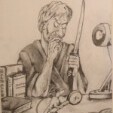
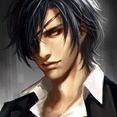
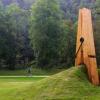
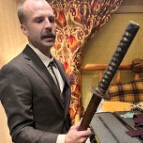
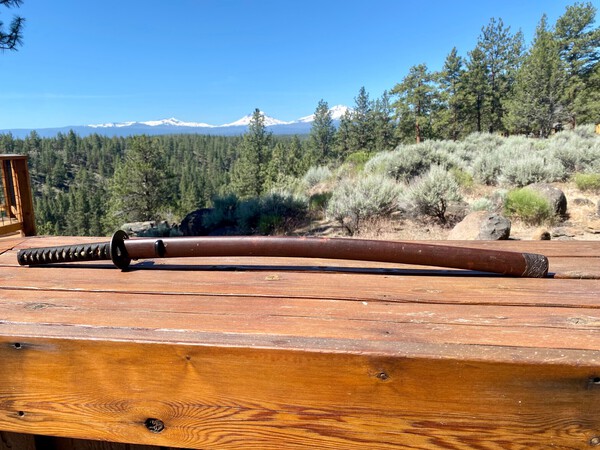

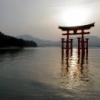

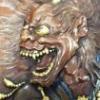
.thumb.png.4c5df79fec171b2dc4a23af38e280a4d.png)
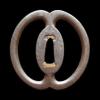


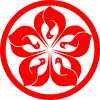
.thumb.jpg.bc10b59027a00aa142dce0349f3ba9e0.jpg)


